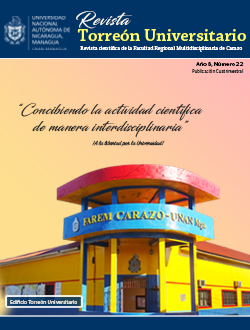Chronic Otitis Media (COM) in adults
DOI:
https://doi.org/10.5377/torreon.v8i22.9026Keywords:
adults, loratadine in chronic otitis media, chronic otitis mediaAbstract
Chronic otitis media is the most advanced state in the spectrum of average otitis. The aim of this investigation was to identify the type of chronic otitis media in Nicaraguan adults 25 - 65 years of age. cross-sectional view in which 312 clinical files of patients diagnosed with the pathogenesis of the ulcers 189 were diagnosed with the diagnosis of chronic otitis media; It became a technique of systematic probabilistic change. A data collection form is used. The variables sometime in the study of age, sex, type of chronic otitis media and pharmacological treatment. For statistical processing of these variables, use the IBM-SPSS® (Statistical Package for Social Sciences) version 25.0 software for Windows 7 32-bit, using Microsoft 365Office® 2010 software package: Microsoft Word® for debugging any writing error or typing thereby facilitating analysis and reproduction of results and Microsoft Excel® for editing graphics and tables for the purpose of having the most information obtained. If you get the following results; The most frequent type of chronic otitis media was the chronic otitis media in cholestomatosis with active infectious process (55%), regardless of whether cholestomatosis or cholestomatosis were the main treatment: loratadine in 55.4% (n = 173), Concluding that chronic mediatic otitis media in cholestomatosa with active infectious process is the type of chronic mediatic otitis that is frequent in an average.
Downloads
8825
PDF 440
HTML (Español (España)) 227
HTML 161
Downloads
Published
How to Cite
Issue
Section
License
Los autores que publican en esta revista están de acuerdo con los siguientes términos.
- El autor o los autores de los artículos, ensayos o investigaciones conceden a la Universidad Nacional Autónoma de Nicaragua, Managua (UNAN-Managua) los derechos de edición (copyright) del trabajo enviado, por consiguiente la Universidad cuenta con el derecho exclusivo para publicar el artículo durante el periodo completo de los derechos de autor.
- Estos derechos de autor/ autores autorizan a la Revista Torreón Universitario y a la Universidad editar y divulgar/publicar el artículo en dicha Revista, incluyendo reproducción impresa y electrónica, el almacenamiento, recuperación y cualquier otro tipo de publicación, y fuentes de información secundaria como servicios de resúmenes y bases de datos, así mismo la facultan a proteger el artículo contra el uso no autorizado para su difusión por medios impresos o electrónicos (PDF, HTML, EPUB, XML u otros).
Licencia para el uso del contenido
La revista hace uso de la Licencia Creative Commons Atribución-NoComercial-SinDerivar 4.0 Internacional.
Bajo esta declaración:

Este revista está sujeta a una licencia de Creative Commons Reconocimiento-NoComercial-SinObraDerivada 4.0 Internacional. Puede ser copiada, distribuida y transmitida públicamente siempre y cuando se cite al autor y la fuente (Revista Torreón Universitario), no debe modificarse ni utilizarse con ningún fin comercial. La licencia completa se puede consultar en http://creativecommons.org/licenses/by-nc-nd/4.0/.



